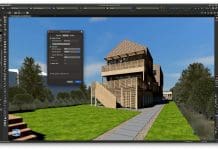BIM Today sits down with AECOM’s Stefan Mordue to discuss future-gazing and the impact digital transformation is already having on construction
Stefan Mordue gives the impression of a man constantly on the go. A chartered architect at 25 who took on a masters in construction project management via distance learning, he has turned a fascination with technology, process and information management into a career in the field of BIM.
While working at NBS, he started to interact with organisations large and small, seeing how they assembled and accessed their information. Soon he was working on the National BIM Library and ended up writing the NBS standard for objects and object creation.
He also met David Philp, a former BIM programme director for Balfour Beatty, current Global BIM Consultancy Director at AECOM and a core team member of Digital Built Britain. Philp is a man who has the “ability to get the right people around the table at the right time,” says Mordue.
Philp invited him to become a founding member of the CIC BIM 2050 Group, along with other professionals under 40 from backgrounds including architecture, surveying and construction management, to examine the future of the industry.
“That really got me involved in future-gazing,” Mordue says.
“I might be coming towards the end of my career in 2050, but what will the profession look like for the next generation? That’s really interesting because you’re trying to prepare present-day students for emerging roles, to solve problems that we don’t yet know are problems using technology that has not yet been invented.”
To help shape that future, Mordue has been involved in the development of a number of BIM standards, including PAS 1192 Part Six for health and safety and BS 8536 for briefing of facilities management. He even found time to co-author the award-winning BIM for Construction Health & Safety and, along with Philp and then-NBS colleague Paul Swaddle, BIM for Dummies.
His latest move has seen him join Philp at multinational engineering firm AECOM’s new consultancy, i3 (icubed). Standing for Information, Integration and Intelligence, i3 by AECOM aims to help clients move into the future by using advanced technologies like machine learning and artificial intelligence for insights that support better decisions, reduce risks and ultimately deliver greater value from their assets.
“We’re starting to really harness the power of data and how you can use it to make better outcomes,” Mordue says.
“John Kizior, the team leader and global director of project technologies, is quite a visionary. AECOM saw a real opportunity to uncork the power of their clients’ data and remove the burden of managing huge amounts of data across the lifecycle. Together with David, they came up with the idea of the consultancy as a response to a much-needed client demand.
“A lot of what we’re doing is very cutting-edge, some of it hasn’t been done before – it’s really pushing the boundaries of what you can do with data.”
i3 brings together coordinated project and portfolio data in real-time throughout an asset’s lifecycle. Digital information is combined with virtual design and construction, information modelling for rapid data capture and computer-generated environments that mimic real behaviour. Clients include government agencies in Singapore, Australia, New Zealand, Scotland and Eastern Europe.
This is not, Mordue says, the stuff of Tomorrow’s World.
“It’s the balance between future-gazing and what we can deliver today,” he says.
“It’s about presenting quite complex data in a simple to use way, either visually or intuitively.”
 Governments and large organisations have, of course, always had lots of data. But, Mordue says, a convergence of advances in modelling, better technology and behavioural changes mean it is only up until recently that we’ve had the capacity and processing speeds to collate this information.
Governments and large organisations have, of course, always had lots of data. But, Mordue says, a convergence of advances in modelling, better technology and behavioural changes mean it is only up until recently that we’ve had the capacity and processing speeds to collate this information.
“And up until recently, BIM case studies have largely been about the design and construction phase,” he adds.
“But what we’re seeing now are some case studies about the utilisation of data throughout the whole lifecycle into operations and maintenance – and arguably that is where the biggest value can be realised.”
At the same time, we are also more open to sharing our data, both personally and professionally, if there are benefits on offer.
“When I’m on Amazon or any kind of shopping channel, in return for giving them some of my information, I’m getting a more tailored experience,” Mordue says.
“I’m happy to give my data as long as an organisation is transparent about what it intends to do with it.”
In construction, the benefits of sharing data between design team, contractor and end user are largely seen in terms of time and cost savings.
Important as they are, Mordue says, getting information flowing through the whole team brings other significant advantages.
For example, he has always been keen to use the technology and processes behind BIM to improve the safety of construction, an area in which he has received awards from the CIOB and Constructing Excellence for his contribution to the industry.
“Historically, we’ve quite good at using digital data throughout design and planning but when it gets into the field, there tends to be more of an analogue way of working,” Mordue says.
“You still see people print out a drawing of a model, laminate it and put it the portacabin, so all that digitisation and the value of that data is lost because it’s now a static drawing.
“But we’re starting to see some real simple ways in which you can get that data flowing throughout the whole team so everybody can make use of it.
“From a health and safety point of view, just having an LCD screen in a site portacabin is really powerful. It doesn’t have to be flythrough visuals but it can be up-to-date information, which is taken from the model and it’s being displayed to those who need to see it.”
To realise the value of data, of course, you need to be able to mine it. This can seem a daunting prospect to many organisations, who have vast amounts of information spread across multiple legacy systems, some paper-based, some digital.
“One of the issues is, how do you bring all this data together? There is a tendency to think that we need to have all our information nicely ordered and structured – and in an ideal world, that would be fantastic – but in the real world, that’s not really how things always happen. Particularly if you’re dealing with legacy data,” Mordue says.
“With some of the powerful searches and by writing particular queries or rule sets, we can start to draw out value from that information.”
Indeed, ‘messy’ or sprawling data can provide more value than a clean, tightly regimented sample by highlighting broad trends or patterns.
“We tend to get a sample of data and scale it up, but that doesn’t always give an accurate picture – as we’ve seen with polls, we got it completely wrong with Brexit, we got it completely wrong on the Scottish independence vote, and that’s all from sample data,” Mordue says.
“With Big Data, you’re looking for patterns and trends. You’ve got Google Translate services, where Google will suck in information from thousands of
pages – some of that information may be incomplete or grammatically incorrect, but because they’re dealing with vast amounts of data, they can start to see those patterns and trends emerging. So that becomes more valuable than a very small, clean dataset.”
Ultimately, unlocking the value of data through digitisation and collaboration can cut costs, save time and makes construction safer – but it is really about realising long-term gains. Future-gazing, if you like.
“Imagine an industry where we have the ability to measure and monitor data in real time? An industry where we can measure ‘in service’ performance. An industry where we can then compare that data to the client’s brief and what was actually constructed.”
Mordue believes that this provides the biggest opportunity to improve not only cost but also carbon performance. In the future, he says, suppliers will be paid “based on what they have delivered and how an asset performs. Its performance outcomes will play a fundamental part of the procurement process”.
“When you look back at the criticisms of the construction industry, not just in the UK but globally, it all boils down to the same thing: the client is not getting best value, they’re not really getting what they asked for, we’re a wasteful industry, we’re not innovating,” says Mordue.
“What was interesting about the government Construction Strategy in 2011 was, despite all these reports going back to the 1930s saying ‘this is the problem’, it said ‘this is the problem – and here are the solutions’. One of those solutions being BIM, others including new forms of procurement, open book tendering and Soft Landings.
“The government would ‘push’ industry by being a better-informed client, essentially. By being really clear about what information they wanted, how they wanted it and when they wanted it.
“On the other hand, they would ‘pull’ industry by giving them all the tools, all the standards and protocols to be able to collaborate and work effectively.”
This is where the future gets exciting, Mordue says.
“It’s all about getting contractors, end users and the clients involved in the process a lot earlier – the clients are not just procuring a physical asset; they’re also procuring a virtual one as really a byproduct of process.
“Rather than delivering a virtual asset that has data which is not going to be much use to them, it’s much more valuable to understand how they are going to use the asset. How do you run the asset? What data do you need? What software and systems do you use?
“On the face of it, it doesn’t sound like rocket science but to get involved in the process early is quite a big mind-set change.”
Stefan Mordue
Regional Consultancy Manager
i3 by AECOM
Tel: +44 (0)7799 680 130
Twitter: @StefanMordue














